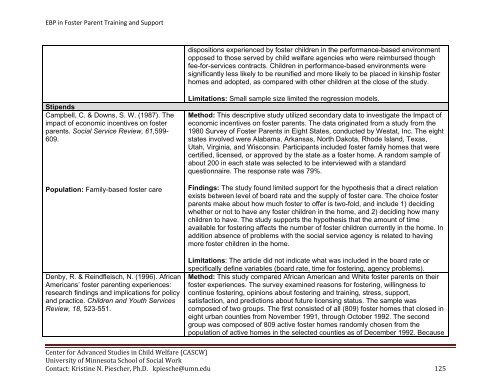Evidence-Based Practice in Foster Parent Training and Support ...
Evidence-Based Practice in Foster Parent Training and Support ...
Evidence-Based Practice in Foster Parent Training and Support ...
Create successful ePaper yourself
Turn your PDF publications into a flip-book with our unique Google optimized e-Paper software.
EBP <strong>in</strong> <strong>Foster</strong> <strong>Parent</strong> Tra<strong>in</strong><strong>in</strong>g <strong>and</strong> <strong>Support</strong>dispositions experienced by foster children <strong>in</strong> the performance-based environmentopposed to those served by child welfare agencies who were reimbursed thoughfee-for-services contracts. Children <strong>in</strong> performance-based environments weresignificantly less likely to be reunified <strong>and</strong> more likely to be placed <strong>in</strong> k<strong>in</strong>ship fosterhomes <strong>and</strong> adopted, as compared with other children at the close of the study.StipendsCampbell, C. & Downs, S. W. (1987). Theimpact of economic <strong>in</strong>centives on fosterparents. Social Service Review, 61,599-609.Population: Family-based foster careDenby, R. & Re<strong>in</strong>dfleisch, N. (1996). AfricanAmericans’ foster parent<strong>in</strong>g experiences:research f<strong>in</strong>d<strong>in</strong>gs <strong>and</strong> implications for policy<strong>and</strong> practice. Children <strong>and</strong> Youth ServicesReview, 18, 523-551.Limitations: Small sample size limited the regression models.Method: This descriptive study utilized secondary data to <strong>in</strong>vestigate the Impact ofeconomic <strong>in</strong>centives on foster parents. The data orig<strong>in</strong>ated from a study from the1980 Survey of <strong>Foster</strong> <strong>Parent</strong>s <strong>in</strong> Eight States, conducted by Westat, Inc. The eightstates <strong>in</strong>volved were Alabama, Arkansas, North Dakota, Rhode Isl<strong>and</strong>, Texas,Utah, Virg<strong>in</strong>ia, <strong>and</strong> Wiscons<strong>in</strong>. Participants <strong>in</strong>cluded foster family homes that werecertified, licensed, or approved by the state as a foster home. A r<strong>and</strong>om sample ofabout 200 <strong>in</strong> each state was selected to be <strong>in</strong>terviewed with a st<strong>and</strong>ardquestionnaire. The response rate was 79%.F<strong>in</strong>d<strong>in</strong>gs: The study found limited support for the hypothesis that a direct relationexists between level of board rate <strong>and</strong> the supply of foster care. The choice fosterparents make about how much foster to offer is two-fold, <strong>and</strong> <strong>in</strong>clude 1) decid<strong>in</strong>gwhether or not to have any foster children <strong>in</strong> the home, <strong>and</strong> 2) decid<strong>in</strong>g how manychildren to have. The study supports the hypothesis that the amount of timeavailable for foster<strong>in</strong>g affects the number of foster children currently <strong>in</strong> the home. Inaddition absence of problems with the social service agency is related to hav<strong>in</strong>gmore foster children <strong>in</strong> the home.Limitations: The article did not <strong>in</strong>dicate what was <strong>in</strong>cluded <strong>in</strong> the board rate orspecifically def<strong>in</strong>e variables (board rate, time for foster<strong>in</strong>g, agency problems).Method: This study compared African American <strong>and</strong> White foster parents on theirfoster experiences. The survey exam<strong>in</strong>ed reasons for foster<strong>in</strong>g, will<strong>in</strong>gness tocont<strong>in</strong>ue foster<strong>in</strong>g, op<strong>in</strong>ions about foster<strong>in</strong>g <strong>and</strong> tra<strong>in</strong><strong>in</strong>g, stress, support,satisfaction, <strong>and</strong> predictions about future licens<strong>in</strong>g status. The sample wascomposed of two groups. The first consisted of all (809) foster homes that closed <strong>in</strong>eight urban counties from November 1991, through October 1992. The secondgroup was composed of 809 active foster homes r<strong>and</strong>omly chosen from thepopulation of active homes <strong>in</strong> the selected counties as of December 1992. BecauseCenter for Advanced Studies <strong>in</strong> Child Welfare (CASCW)University of M<strong>in</strong>nesota School of Social WorkContact: Krist<strong>in</strong>e N. Piescher, Ph.D. kpiesche@umn.edu 125
















